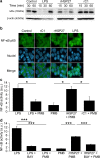Extracellular HSP27 acts as a signaling molecule to activate NF-κB in macrophages
- PMID: 22851137
- PMCID: PMC3508120
- DOI: 10.1007/s12192-012-0356-0
Extracellular HSP27 acts as a signaling molecule to activate NF-κB in macrophages
Abstract
Heat shock protein 27 (HSP27) shows attenuated expression in human coronary arteries as the extent of atherosclerosis progresses. In mice, overexpression of HSP27 reduces atherogenesis, yet the precise mechanism(s) are incompletely understood. Inflammation plays a central role in atherogenesis, and of particular interest is the balance of pro- and anti-inflammatory factors produced by macrophages. As nuclear factor-kappa B (NF-κB) is a key immune signaling modulator in atherogenesis, and macrophages are known to secrete HSP27, we sought to determine if recombinant HSP27 (rHSP27) alters NF-κB signaling in macrophages. Treatment of THP-1 macrophages with rHSP27 resulted in the degradation of an inhibitor of NF-κB, IκBα, nuclear translocation of the NF-κB p65 subunit, and increased NF-κB transcriptional activity. Treatment of THP-1 macrophages with rHSP27 yielded increased expression of a variety of genes, including the pro-inflammatory factors, IL-1β, and TNF-α. However, rHSP27 also increased the expression of the anti-inflammatory factors IL-10 and GM-CSF both at the mRNA and protein levels. Our study suggests that in macrophages, activation of NF-κB signaling by rHSP27 is associated with upregulated expression and secretion of key pro- and anti-inflammatory cytokines. Moreover, we surmise that it is the balance in expression of these mediators and antagonists of inflammation, and hence atherogenesis, that yields a favorable net effect of HSP27 on the vessel wall.
Figures




Similar articles
-
Heat shock protein-27 attenuates foam cell formation and atherogenesis by down-regulating scavenger receptor-A expression via NF-κB signaling.Biochim Biophys Acta. 2013 Dec;1831(12):1721-8. doi: 10.1016/j.bbalip.2013.07.015. Epub 2013 Aug 11. Biochim Biophys Acta. 2013. PMID: 23939398
-
Inhibitory effect of chroman carboxamide on interleukin-6 expression in response to lipopolysaccharide by preventing nuclear factor-kappaB activation in macrophages.Eur J Pharmacol. 2006 Aug 14;543(1-3):158-65. doi: 10.1016/j.ejphar.2006.05.042. Epub 2006 Jun 2. Eur J Pharmacol. 2006. PMID: 16797005
-
Euscaphic acid isolated from roots of Rosa rugosa inhibits LPS-induced inflammatory responses via TLR4-mediated NF-κB inactivation in RAW 264.7 macrophages.J Cell Biochem. 2012 Jun;113(6):1936-46. doi: 10.1002/jcb.24062. J Cell Biochem. 2012. PMID: 22234926
-
Posttranslational modifications of NF-kappaB: another layer of regulation for NF-kappaB signaling pathway.Cell Signal. 2010 Sep;22(9):1282-90. doi: 10.1016/j.cellsig.2010.03.017. Epub 2010 Apr 2. Cell Signal. 2010. PMID: 20363318 Free PMC article. Review.
-
[Inflammaging: the signaling role of p65 protein from the NF-κB family.].Adv Gerontol. 2024;37(4):410-414. Adv Gerontol. 2024. PMID: 39531300 Review. Russian.
Cited by
-
Sex differences in COVID-19 mortality: opportunity to develop HSP27 (HSPB1) immunotherapy to treat hyper-inflammation?Cell Stress Chaperones. 2020 Sep;25(5):725-729. doi: 10.1007/s12192-020-01146-5. Epub 2020 Aug 6. Cell Stress Chaperones. 2020. PMID: 32761452 Free PMC article. No abstract available.
-
Extracellular Release and Signaling by Heat Shock Protein 27: Role in Modifying Vascular Inflammation.Front Immunol. 2016 Jul 26;7:285. doi: 10.3389/fimmu.2016.00285. eCollection 2016. Front Immunol. 2016. PMID: 27507972 Free PMC article. Review.
-
Tramadol regulates the activation of human platelets via Rac but not Rho/Rho-kinase.PLoS One. 2023 Jan 13;18(1):e0279011. doi: 10.1371/journal.pone.0279011. eCollection 2023. PLoS One. 2023. PMID: 36638092 Free PMC article.
-
Heat shock proteins: Biological functions, pathological roles, and therapeutic opportunities.MedComm (2020). 2022 Aug 2;3(3):e161. doi: 10.1002/mco2.161. eCollection 2022 Sep. MedComm (2020). 2022. PMID: 35928554 Free PMC article. Review.
-
Determinants of rodent longevity in the chaperone-protein degradation network.Cell Stress Chaperones. 2016 May;21(3):453-66. doi: 10.1007/s12192-016-0672-x. Epub 2016 Feb 19. Cell Stress Chaperones. 2016. PMID: 26894765 Free PMC article.
References
Publication types
MeSH terms
Substances
Grants and funding
LinkOut - more resources
Full Text Sources
Other Literature Sources
Research Materials
Miscellaneous

